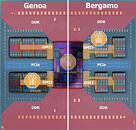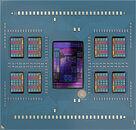- Joined
- Oct 9, 2007
- Messages
- 47,770 (7.42/day)
- Location
- Dublin, Ireland
| System Name | RBMK-1000 |
|---|---|
| Processor | AMD Ryzen 7 5700G |
| Motherboard | Gigabyte B550 AORUS Elite V2 |
| Cooling | DeepCool Gammax L240 V2 |
| Memory | 2x 16GB DDR4-3200 |
| Video Card(s) | Galax RTX 4070 Ti EX |
| Storage | Samsung 990 1TB |
| Display(s) | BenQ 1440p 60 Hz 27-inch |
| Case | Corsair Carbide 100R |
| Audio Device(s) | ASUS SupremeFX S1220A |
| Power Supply | Cooler Master MWE Gold 650W |
| Mouse | ASUS ROG Strix Impact |
| Keyboard | Gamdias Hermes E2 |
| Software | Windows 11 Pro |
A SemiAnalysis report sheds light on just how much smaller the "Zen 4c" CPU core is compared to the regular "Zen 4." AMD's upcoming high core-count enterprise processor for cloud data-center deployments, the EPYC "Bergamo," is based on the new "Zen 4c" microarchitecture. Although with the same ISA as "Zen 4," the "Zen 4c" is essentially a low-power, lite version of the core, with significantly higher performance/Watt. The core is physically smaller than a regular "Zen 4" core, which allows AMD to create CCDs (CPU core dies) with 16 cores, compared to the current "Zen 4" CCD with 8.
The 16-core "Zen 4c" CCD is built on the same 5 nm EUV foundry node as the 8-core "Zen 4" CCD, and internally features two CCX (CPU core complex), each with 8 "Zen 4c" cores. Each of the two CCX shares a 16 MB L3 cache among the cores. The SemiAnalysis report states that the dedicated L2 cache size of the "Zen 4c" core remains at 1 MB, just like that of the regular "Zen 4." Perhaps the biggest finding is their die-size estimation, which puts the 16-core "Zen 4c" CCD just 9.6% larger in die-area, than the 8-core "Zen 4" CCD. That's 72.7 mm² per CCD, compared to 66.3 mm² of the regular 8-core "Zen 4" CCD.



The SemiAnalysis report states that the codename AMD assigned to the "Zen 4c" core itself, is "Dionysus," while the 16-core CCD is codenamed "Vindhya." The 128-core/256-thread "Begamo" EPYC 9754 processor is a chiplet-based multi-chip module, designed for existing Socket SP5 server infrastructure. The MCM features no more than eight "Zen 4c" CCDs to achieve its core-count of 128.
The Server I/O Die (sIOD) is built on the 6 nm process, and appears to be the same one found in EPYC "Genoa" processors. It features a 12-channel (24 sub-channel) DDR5 memory interface, and a PCI Express 5.0 x128 root-complex. The EYPC 9754 is a 400 W TDP-class processor, just like the top "Genoa" processor, but with much higher compute density. "Zen 4c" is shaping up to be AMD's answer to Intel's E-cores such as "Gracemont," the article notes.
View at TechPowerUp Main Site | Source
The 16-core "Zen 4c" CCD is built on the same 5 nm EUV foundry node as the 8-core "Zen 4" CCD, and internally features two CCX (CPU core complex), each with 8 "Zen 4c" cores. Each of the two CCX shares a 16 MB L3 cache among the cores. The SemiAnalysis report states that the dedicated L2 cache size of the "Zen 4c" core remains at 1 MB, just like that of the regular "Zen 4." Perhaps the biggest finding is their die-size estimation, which puts the 16-core "Zen 4c" CCD just 9.6% larger in die-area, than the 8-core "Zen 4" CCD. That's 72.7 mm² per CCD, compared to 66.3 mm² of the regular 8-core "Zen 4" CCD.



The SemiAnalysis report states that the codename AMD assigned to the "Zen 4c" core itself, is "Dionysus," while the 16-core CCD is codenamed "Vindhya." The 128-core/256-thread "Begamo" EPYC 9754 processor is a chiplet-based multi-chip module, designed for existing Socket SP5 server infrastructure. The MCM features no more than eight "Zen 4c" CCDs to achieve its core-count of 128.
The Server I/O Die (sIOD) is built on the 6 nm process, and appears to be the same one found in EPYC "Genoa" processors. It features a 12-channel (24 sub-channel) DDR5 memory interface, and a PCI Express 5.0 x128 root-complex. The EYPC 9754 is a 400 W TDP-class processor, just like the top "Genoa" processor, but with much higher compute density. "Zen 4c" is shaping up to be AMD's answer to Intel's E-cores such as "Gracemont," the article notes.
View at TechPowerUp Main Site | Source



